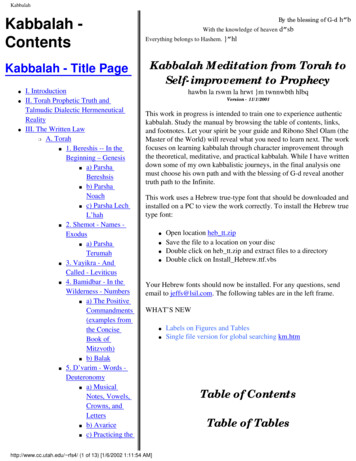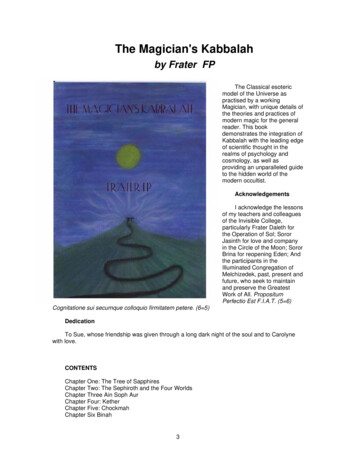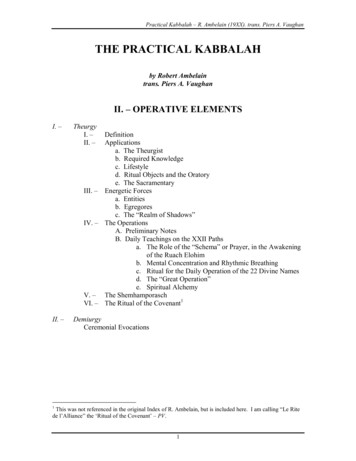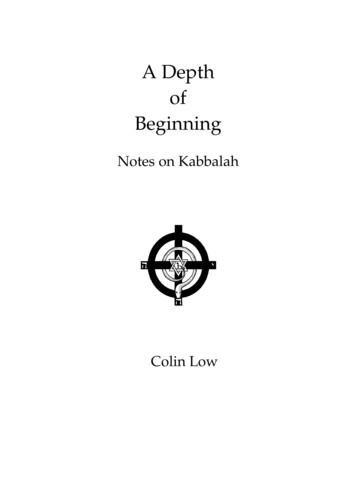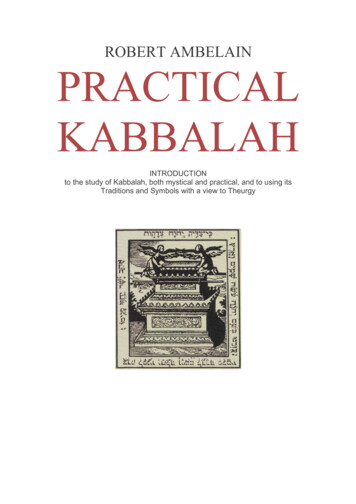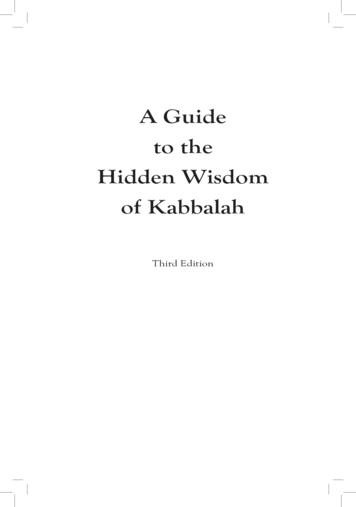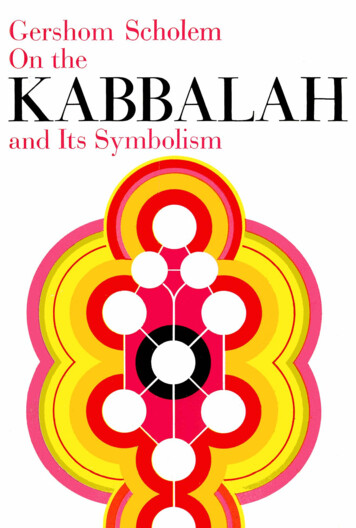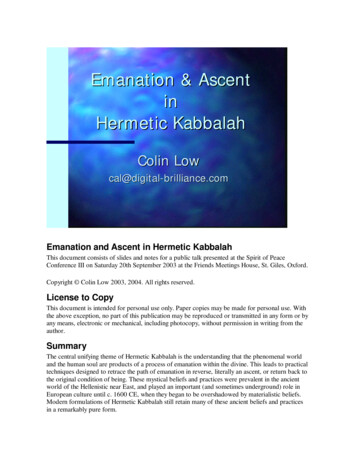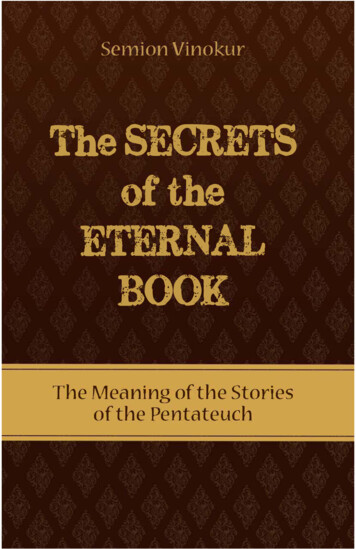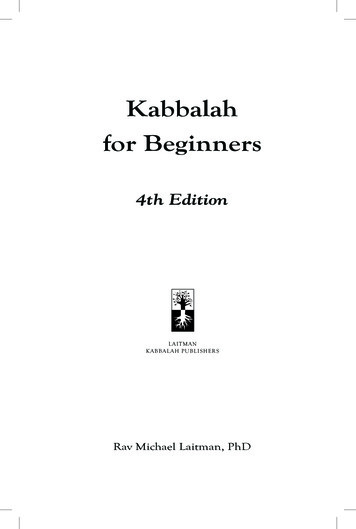
Transcription
Kabbalahfor Beginners4th EditionL AI TMANKABBAL AH PUBL I SHERSRav Michael Laitman, PhD
KABBALAH FOR BEGINNERSCopyright 2007 by MICHAEL LAITMANAll rights reservedPublished by Laitman Kabbalah Publisherswww.kabbalah.infoinfo@kabbalah.info1057 Steeles Avenue West, Suite 532, Toronto, ON, M2R 3X1, Canada194 Quentin Rd, 2nd floor, Brooklyn, New York, 11223, USAPrinted in CanadaNo part of this book may be used or reproducedin any manner without written permission of the publisher,except in the case of brief quotations embodiedin critical articles or reviews.Library of Congress Cataloging-in-Publication DataLaitman, Michael.Kabbalah for beginners / Michael Laitman. — 4th ed.p. cm.ISBN 978-0-9781590-9-21. Cabala. I. Title.BM525.L252 2007296.1’6—dc222007021769Research: Eli Vinokur, Oren LeviPhotos: Moshe AdmoniLayout: Richard AquanGraphics: Baruch KhovovCopy Editor: Claire GerusPrinting and Post Production: Uri LaitmanExecutive Editor: Chaim RatzFOURTH EDITION: OCTOBER 2007First printing
KABBALAH FOR BEGINNERSTA B L E O F C O N T E N T SINTRODUCTION . 9PART ONE: THE HISTORY OF KABBALAH . 13CHAPTER 1: KABBALAH CHRONICLES . 15Stage One . 16Stage Two . 23Stage Three . 25CHAPTER 2: TIMELESS TEACHERS OF KABBALAH . 27Rabbi Akiva . 28The Turning Point. 29Discovering the Law of Love . 30The Bar-Kokheva Revolt. 31Two Blows to Rabbi Akiva’s Work. 31Rabbi Shimon Bar-Yochai (Rashbi) . 32From Student to Fugitive . 34The Cave at Piqiin. 34One in Millions . 36Isaac Luria (the Holy Ari) 1534-1572. 37A Man of Mystery and Legend. 37Preparing for the Revelation . 38Rabbi Yehuda Leib HaLevi Ashlag (Baal HaSulam) 1884-1954 . 40His Major Works . 41Spreading the Word . 43
PART TWO: THE (GIST OF THE) WISDOM OF KABBALAH . 45CHAPTER 3: THE ORIGIN OF CREATION . 47The Spiritual Worlds. 47The Thought of Creation. 48Four Basic Phases (and their root) . 49Phase Four – Craving the Creator’s Mind . 54The Quest for the Thought of Creation . 56The Route . 62Using the Screen . 62Workable and Unworkable Desires . 65The Common Soul . 67The Great Fall . 68CHAPTER 4: MENDING ADAM TO ACHIEVE PERFECTION . 71The Pyramid . 74The Making of Life . 75As Above, So Below . 77Up the Ladder . 79Building the Vessel . 82The Desire for Spirituality . 85Phase Four – the Phase of Conscious Evolution . 87PART THREE: TALK ABOUT REALITY . 91CHAPTER 5: ALL IN ONE AND ONE IN ALL . 93Three Boundaries in Studying the Upper Worlds . 96First Boundary—What We Perceive. 96Second Boundary—Where We Perceive . 97Third Boundary—Who Perceives . 98Perceiving Reality Correctly .101A Nonexistent Reality . 103The MeasurementMechanism . 105The Sixth Sense . 107Create Your Perfect Reality . 109The Thought of Creation .112Back to the Future.113Two Approaches, Two Paths .114Desire Makes for Progress . 115
PART FOUR: CRISIS AND CORRECTION .119CHAPTER 6: A NEW METHOD FOR A NEW DESIRE . 123The Dark before the Dawn . 123A Brave New World in Four Steps. 128Know Your Limits .131The Reins of Life . 133Changing Society to Change Myself . 135CHAPTER 7: THE FOUR FACTORS OF OUR MAKE-UP . 139Choosing the Right Environment for Correction. 142No Room for Anarchists . 146The Ego’s Inevitable Death.147The Cure . 150Fake Freedom . 152Concealment—a Requisite for Free Choice . 153Implementing Free Choice . 154Faith . 155Reason . 155APPENDIXES. 159APPENDIX ONE: FREQUENTLY ASKED QUESTIONS . 160What Is the Wisdom of Kabbalah? . 160What Is Spirituality? . 163The Revelation of the Creator . 164Kabbalah Is Not Mysticism . 166Studying Kabbalah . 168Body, Soul, and Reincarnation . 172APPENDIX TWO: FURTHER READING . 178Beginners . 179Intermediate .181Advanced . 182All Around . 183APPENDIX THREE: ABOUT BNEI BARUCH . 186History and Origin . 186The Study Method . 187The Message . 188Activities . 189How to Contact Bnei Baruch . 192
INTRODUCTIONScientists have been studying the laws of Nature, our be-havior, and our place in the world for thousands of years.Yet, these days, scientists are realizing that the more theyadvance in their research, the more confusing they findthe world to be.While science has undoubtedly brought enormousprogress to our lives, there are boundaries beyond whichit cannot penetrate. For instance, scientific tools cannotmeasure the human soul, or the basic motivation for ouractions. If it could, we would be able to “program” peopleto behave as we wish. But because we cannot perceive ourmost essential motivations, we humans, the apex of Cre-ation, are still unaware of why we come into this world!Man has always been searching for the answers tolife’s most basic questions: “Who am I?” “What is the9
10K ABBALAHFORB EGINNERSpurpose of my life?” “Why does the world exist?” “Do wecontinue to exist after our physical being has ended?”In the absence of sufficient answers, some find tem-porary refuge in Eastern teachings, meditations, or tech-niques that minimize personal expectations and reducethe suffering caused by disillusionment.However, experience teaches us that we can neversatisfy all our desires; therefore, we will always experi-ence some degree of discontentment. Yet, at the deepestlevel of our being, the true basis for suffering arises fromour inability to answer life’s most fundamental question:“Why am I here?”Kabbalah answers this very question, and in doingso, guides us toward complete and lasting satisfaction.It teaches us how to access the essential feeling of thespiritual realm—the sixth sense—and thus improve ourlives in this world. With it, we can perceive the UpperWorld—the Creator—and assume control over our lives.The Bible, The Book of Zohar, The Tree of Life, The Studyof the Ten Sefirot, and other authentic Kabbalistic sourceswere given to us to promote us in the spiritual realms.With their help, we can obtain spiritual knowledge. Theyexplain how we can turn our lives in this world into apath to spiritual ascent.Over the generations, Kabbalists have written manybooks in various styles, each adapted to the era in whichthey lived. Similarly, Kabbalah for Beginners has been writ-ten to help you take your first steps towards understanding
Introduction11the roots of human behavior and the laws of Nature. Thecontents present the essential principles of the wisdomof Kabbalah and describe how these principles work.This book is intended for those searching for a reliablemethod of studying our world. It is written for those seek-ing to understand the reasons for suffering and pleasure,who strive to take charge over their lives and make themthe exciting and joyous journeys they can be.* This book is based on essays and lectures given by RavMichael Laitman, PhD, which were then edited by staffmembers of the Ashlag Research Institute (ARI).
PART ONEThe Historyof Kabbalah
There is no real difference between the history ofKabbalah and the history of the world, except thatKabbalah tells the same story from the spiritualperspective. It is similar to examining our lives from twovery different perspectives. From the historical perspec-tive, our past is a sequence of events that happened to usor to our ancestors, while from the Kabbalistic perspec-tive, our past is a sequence of spiritual events, expressedin a series of scenes we call “life on Earth.”As we will see in Part Three, history isn’t really “un-folding” in Kabbalah; rather, it is experienced withineach and every one of us separately. Kabbalists don’t re-late to the external reality as a tangible reality, but explainthat what we perceive as “external” is really a reflection ofimages that exist only within us.Part One of the book will discuss the history of Kab-balah as experiences that occurred in the physical world.Part Two will explore the origin and structure of reality. PartThree will examine our inner reality, and Part Four com-bines all three into one coherent, practical worldview.
1KABBALAH CHRONICLESThe Rambam (Maimonides), a great 12th century Kab-balist, wrote that thousands of years ago, when humanitywas deep in idol worship, one man couldn’t g
Kabbalah answers this very question, and in doing so, guides us toward complete and lasting satisfaction. It teaches us how to access the essential feeling of the spiritual realm—the sixth sense—and thus improve our lives in this world. With it, we can perceive the Upper World—the Creator—and assume control over our lives. The Bible, The Book of Zohar, The Tree of Life, The Study of .File Size: 1MBPage Count: 39
